
|
|
|
|
 |
|
Home Site Search Contact Us Subscribe
|
|
|
|
INSIGHT: Transit-Oriented Design: An Evolution from Societal Convenience to Environmental Solution
TOD is the model for what multi-family housing will look like in the years ahead. By John Burcher, AIA February 12, 2008 The green movement is gaining wider acceptance within the residential sector. The U.S. Green Building Council (USGBC) recently noted that more than 8,200 single- and multi-family homes nationwide are involved in its LEED for Homes pilot program; 336 homes have already received LEED certification. Other market reports suggest that – given housing market forecasts and other economic trends – the market for green homes or sustainable components is expected to increase to 10% by 2010.
Clearly, promoting an environmental position enhances corporate social responsibility. One particular initiative – the transit-oriented development (TOD) – offers a clear vision of taking that responsibility beyond what is socially expected. The TOD is the model for what multi-family housing will look like in the years ahead. Many TOD projects are included in the USGBC’s LEED-ND/Neighborhood Development pilot program, with 238 projects already registered, including: 108 N. State Street, Chicago; Atlantic Yards Development, Brooklyn, NY; City Creek Center, Salt Lake City, UT; Transit-Oriented Develop District, Irvine, CA; and MacArthur BART Transit Village, Oakland, CA.
Many developers – along with the Urban Land Institute (ULI) – have embraced these initiatives, and have addressed their potential value as TODs have evolved. In a 2003 report addressing TODs’ barriers and incentives, the ULI noted that TOD is an important component in a community’s tool kit to achieve regional growth management goals and objectives. However, it is not a “silver bullet” for economic and other problems faced by jurisdictions. TOD operates in and is supported by a multimodal transit and land use environment, but TOD and transit do not by themselves create a successful market. The reverse is true: the market creates opportunities for TOD.
The Future of Multi-Family Housing
The goal of TOD developments is to create vibrant, livable communities centered on public transportation systems. They also impact land’s usefulness and vitality: developers are building such multi-housing sites in urban areas on once vacant (often brownfield) land. These developments provide but one solution to dependence on the world oil markets and global warming by reducing the need to drive, thereby decreasing pollution levels caused by burning fossil fuels and carbon emissions.
There is plenty of evidence to suggest TODs are effective market catalysts. Investments in transportation infrastructure spark commercial and residential interest in surrounding areas which would have otherwise been dismissed as urban wastelands. Dense urban areas where existing transit systems prevail are candidates for TOD development.
In the 1920s, Chicago’s Oak Park (nine miles west of the city) was one of the area’s first TODs because of the public transportation links to Chicago’s business district. In the 1940s, Ravenswood (at that time, Chicago’s northern edge) soon followed because of the direct access to downtown Chicago on public trolley and train lines. Washington, DC’s transit system has helped evolve the TOD concept to what it is today. Portland, Denver, Cleveland, Los Angeles, and Austin, TX (where streetcars are integrated throughout the University of Texas campus and Mueller Airport) are among the metropolitan areas where TODs have been enacted.
DeStefano + Partners has been involved in a TOD project outside of St. Louis. Developed by Orchard Development Group, the $150 million, mixed-use Trianon in Clayton has direct access to a new MetroLink train station. The development consists of a 26-story condominium tower, one mid-rise residential building, extensive public and private gathering spaces, and nearly 30,000 square feet of retail space.
The key to Trianon’s position in the marketplace is that it offers conveniences that attract a wide audience of homeowners, especially transit riders and pedestrians. The property’s engaging campus invites people to walk past restaurants and retail shops, bringing liveliness along the street that supports local businesses. It is likely that Trianon’s design will spur development of surrounding sites in the downtown Clayton neighborhood by creating newfound density. In turn, this will help reinforce more residential and commercial development in the area, especially along Forsyth Avenue – one of downtown Clayton’s main streets – and further on to Washington University.
Beyond Big Cities
Skeptics may think that this sort of design strategy only adds real value for metropolitan areas with large populations and finite amounts of space. But TOD concepts have significant social and environmental benefits for all communities: • A reduced dependence on oil and other fossil fuels; • Reduced costs in building and maintaining infrastructure (e.g., roads); • Greater street liveliness and pedestrian traffic have benefits of sociability and security; • Reduction in traffic and congestion; • Cleaner places to work, live, and play.
The question at this point might be: “What if our city doesn’t have strong public transportation?” Tampa, FL, officials addressed its lack of bus and train lines by building trolley lines throughout its downtown area, while also promoting scooter and bicycle usage. A bus or train line isn’t required for a TOD – there are certainly other options to address conserving energy and improving the environment.
We’re not proposing that TOD is the be-all-and-end-all of environmental woes. We suggest that TOD offers developers and real estate influencers an opportunity to position their portfolios for the future and make a name for themselves in the area of urban progress. We are also suggesting that government agencies and other planning officials can do more to recognize the need for TODs for zoning and planning purposes, and that these people can work in concert with neighborhood organizations who want to maintain the character of their communities.
Making TODs possible requires developing a community consensus around development goals and objectives, and then moving forward in an efficient process to realize the vision. Critical to the communication process are the local jurisdictions and their relationship to their neighborhoods, businesses, chambers of commerce, and community groups. Ultimately, TODs will flourish when regional planning/development authorities and government officials work together with architects, developers, and community leaders.
From our vantage point, the key to a successful TOD development starts with site plans that include a walkable design, with the pedestrian being the focal point of all design components. The next focal point is lifestyle-driven – what are the types of properties, uses, and systems needed to keep people from getting into their cars?
The next phase of a development’s integration details the incorporation of the transportation infrastructure. It can focus around an existing public transit line or the creation of paths for bicycles, scooters, rollerblades, and walking. A successful TOD development needs to incorporate a mixture of uses in close proximity, including office, retail, and civic activities. It’s at this point when actual structures should be planned.
Next Wave of TOD
DeStefano + Partners speculates that an increased number of urban planners – in cities of all sizes – will realize that constructing traditional roadways will have an adverse effect on alleviating congestion. Yet, we recognize that not every city is equipped to properly support TOD development.
Current trends in TOD are expanding to include more flexible concepts. Transit-Adjacent Developments (TAD) – including Lindbergh City Center in Atlanta – are adjacent to transit systems, but step away from traditional TOD mindsets like making public spaces the focus of building orientation and neighborhood activity; creating pedestrian-friendly street networks that directly connect local destinations; and providing a mix of housing types and densities.
Yet another level of TOD is emerging – the use of shared vehicle concepts. I-Go and Zipcar – innovative membership-driven business models which have cars parked around the city for members to drive by the hour instead of owning vehicles, and community bicycle programs reduce the number of automobiles in urban areas, cutting down on traffic congestion and air pollution. International cities including Paris, London, Barcelona, and Stockholm have already implemented community bicycle programs.
Communities will flourish when planners and planning departments embrace density near transportation hubs. Architects need to stay ahead of the curve for the purpose of helping their developer partners be successful. As homebuyers place a greater emphasis on social and environmental responsibility, we need to think about how to design better living environments. TODs continue to evolve from a convenience of urban living to a viable – or even preferred – option to conserve resources.
John Burcher, AIA, is a Design Principal at DeStefano + Partners, a Chicago-based architecture, urban planning, and interior design practice established in 1988. With offices in Chicago and Los Angeles, the firm serves private and public sector clients in meeting design, planning, programming, and assessment needs in new construction and renovation.
|
(click on pictures to enlarge) 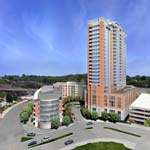 (DeStefano + Partners) Mixed-use Trianon complex in Clayton, Missouri, just west of St. Louis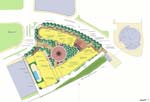 (DeStefano + Partners) Site plan: MetroLink station, upper right, includes underground pedestrian link to the complex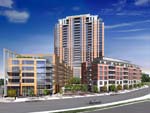 (DeStefano + Partners) The residential complex includes both low- and high-rise rental and condominium units as well as streetfront retail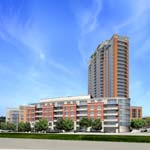 (DeStefano + Partners) Mid-rise building for retail and rental residences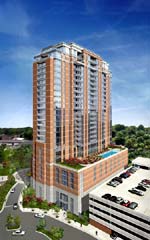 (DeStefano + Partners) Trianon condominium tower and parking garage |
© 2008 ArchNewsNow.com